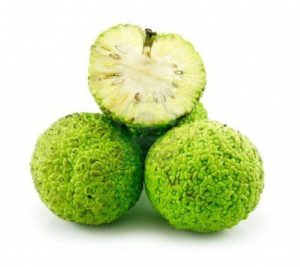Highly revered in Native American cultures, the Osage tree is has admired for centuries. The bark, fruits, and leaves all contain phytonutrients that are responsible for the tree’s proposed health benefits.
Contents
Uses
The Comanche tribe historically utilized a root/water infusion for eye conditions. Other folk uses of the plant include its use by Native Americans as a cancer treatment; in Bolivia, the plant’s sap has been used to treat tooth pain, and the bark and leaves are used to treat uterine bleeding. One active compound found within Osage oranges is Tetrahydroxystilbene which shows significant antifungal activity and is also known as an analog of resveratrol, a compound that may have anti-cancer effects in humans and animals, although experimental results are inconsistent.
The fruit of the Osage orange contains high concentrations of isoflavones relative to other plants containing the natural compounds. Consumption of isoflavones has been linked to cancer prevention, improved bone health and reduced risk of heart disease, and the compounds may also play a role in the prevention of Alzheimer’s disease. However, researchers investigating the production of isoflavones within Osage oranges cautioned against ingesting the fruit, which would likely cause stomach irritation
Benefits
Harmful Organism Protection
Some research shows that the Osage tree contains potent compounds responsible for fighting various types of fungus and bacteria. Research is ongoing to determine how these compounds can be applied to human health. The main chemical compound that exhibits fungal and bacterial fighting abilities is 2,3,4,5-tetrahydroxystilbene and is found primarily in the wood.
Cardiovascular Support
Heart disease is the number one killer among men and women alike, and researchers are scrambling to find solutions. Flavonoids found in the Osage tree — osajin and pomiferin — have been shown to promote heart function in animal tests; largely due to its antioxidant activity.
Antioxidant Power
Many degenerative health problems are amplified by oxidative stress — metabolic stress induced by diet and environmental toxins. Dietary antioxidants offer a great deal of promise for decreasing oxidative stress in the body and supporting overall health. The Osage tree contains high levels of isoflavones, a type of antioxidant similar to vitamin C and E.
Immune System Support
The immune system is the most important factor for supporting our health, providing a barrier against infectious and viral bacteria. The immune system can become compromised through stress, improper diet, and lack of exercise. Research shows that pomiferin, a natural antioxidant in the Osage tree, significantly boosts immune system function.
Insecticide
Unlike other trees, the Osage tree is typically free from pests, an allusion to its natural insecticide activity. Some limited preliminary research suggests concentrated compounds extracted from the fruit of the Osage tree may repel insects
Cautions
No side effects are known.
Interactions
None are recorded.
Other names
hedge apple, horse apple, bois d’arc, bodark, bow-wood, yellow-wood, mock orange and monkey ball
References
Source: Wikipedia, https://en.wikipedia.org/wiki/Maclura_pomifera#Medicinal_properties
GlobalHealingCenter, http://www.globalhealingcenter.com/natural-health/health-benefits-of-the-osage-tree/

